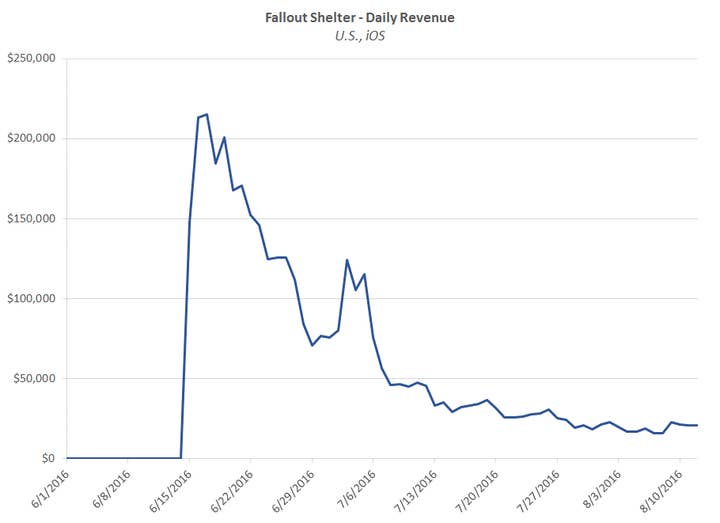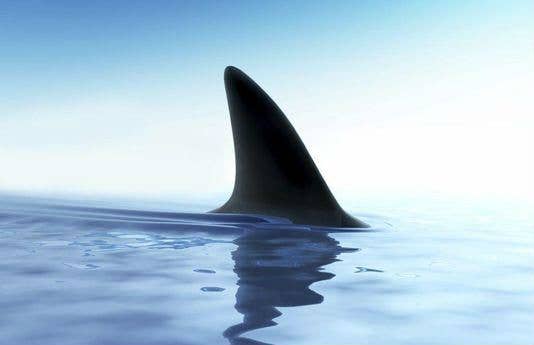$10m+ Production Budgets: Avoiding the Shark Fin
Kabam CEO Kevin Chou details a familiar pattern of decline in free-to-play mobile games, and what developers can do to avoid it
The following article was submitted by Kabam CEO Kevin Chou as part of a discussion that started with an interview about a shift in high-end mobile game development, and continued with Rob Fahey's appraisal of mobile as an increasingly "indie hostile market." For the full picture, feel free to read or revisit the conversation so far.
Much has been said on why mobile game budgets are rapidly rising. While this trend can be partially attributed to the increasing prevalence of 3D graphics, I'd like to explore several other facets that impact Kabam's production strategy and thus budgets. Specifically, the majority of our production resources are spent on building the foundation for multiple gameplay and growth lines that keep "Regulars" playing for years (Regulars is a Kabam terminology for the core of a free-to-play player community and thus our business). Without these vectors in the game at launch, a product will inevitably become victim to the sharp fall-off in engagement and retention we've seen time and time again.
"We tailor our budgets to deliberately avoid a phenomenon we call the 'shark fin'"
In short, we tailor our game budgets to deliberately avoid a phenomenon we call the "shark fin."
A shark fin is a game that launches with a cultural groundswell of downloads due to gameplay market fit heat, platform featuring and press coverage, among other factors. Shark fins also tend to have good but not great monetization designs. These games rise rapidly on both the Top Downloaded and Top Grossing charts for the first 7 to 30 days, but then, as word of mouth and overall momentum fades, the game plummets down the Top Downloaded chart. It then rapidly declines on the Top Grossing chart a few weeks later. Here's a real-world example of a great game that succumbed to this phenomenon last summer:

A key reason shark fins exist is the free-to-play design approach of building a minimal viable game for launch, then, if it's an early hit, laying tracks ahead of the train after it leaves the station. However, we've now learned that the core players of a game often consume its content so quickly that this strategy inevitably leads to the train reaching the front of the track much faster than the developer anticipated - or can remedy. By spending valuable resources on building out core game features months or years after launch, it becomes infeasible to simultaneously keep up with the content demands of players in both quantity and quality. This leads to a lopsided game of cat and mouse, and, when the delta between content and player needs becomes too great, results in a shark fin.
"It's our responsibility to create captivating open roads for our players to traverse, not disjointed, maze-like experiences that prioritize monetization"
For larger game developers, a shark fin represents the worst case scenario: a lost franchise opportunity. Most developers, Kabam included, have commercially released new games that stumbled out of the gate. That's simply part of the business. But a shark fin means a game was on the cusp of greatness, with a significant audience, a gameplay loop that drove download heat along with early retention, and solid early monetization. What it lacked was long term retention, the consequence of launching with a minimal viable game.
Kabam's years of operating free-to-play games have led to five principle ingredients we feel are necessary for not only the successful launch of a game, but also the foundation that underpins the subsequent years of live service our games must have on day one of launch.
First is an approach to gameplay that gives the title an outsized chance of achieving high download heat. In the case of Marvel Contest of Champions, lovingly crafted by our Vancouver studio, we focused on a compelling mix of fighting genre innovation, a renowned IP license, and AAA visuals. The Vancouver studio was passionate about innovating on fighting game mechanics to feel intuitive on a touch screen. While other fighting games opt for virtual onscreen buttons, we developed a wholly gesture-based control scheme that integrates an established three-tier attack system, but also enables players to concentrate on the moment-to-moment action without worrying where their fingers are. This system is buttressed by an advanced combo and defense framework that empowers players to make deep strategic fighting choices. Our gameplay innovation, along with setting a new graphical bar on mobile for the genre and delivering on Marvel's brand promise, makes it clear within seconds that Marvel Contest of Champions offers players a distinct fighting game experience.
The second key ingredient is an extensible economy foundation with multiple well designed growth lines. It is far too common in our industry to see games that simply tack on extra features or items to the primary gameplay post launch in an attempt to monetize players and add a short bit of content runway. This approach worked in the early years of free-to-play when a game's engagement cycles and lifespan were assumed to be minutes and months, respectively. But players today - particularly Regulars who play 40+ hours a week - require new economy designs that enable thoughtfully integrated styles of gameplay and economy interactions. It is our responsibility as game makers to create captivating open roads for our players to traverse, not disjointed, maze-like experiences that prioritize monetization. At Kabam, we do this by thinking about our gameplay loops and economies as a series of concentric circles where each part of the experience follows intuitively from the one before it and cannot exist on its own. We call these growth lines internally.
"For larger game developers, a shark fin represents the worst case scenario: a lost franchise opportunity"
The outer rings of our games contain the third necessary ingredient: a deep elder game loop ("elder game" is jargon for when players reach a point in the game where level advancement is no longer the goal and other activities in the game become the appeal). These gameplay loops typically come after the linear content - a single-player narrative campaign, for example - are relatively self-sustaining between content updates, and are what enable games to have a high replayability factor. The simple fact is that players often progress through a game's linear content much quicker than any developer is able to produce it. Thus we need compelling elder game systems after the linear content that players can engage in regardless of when they actually reach it. Elder gameplay loops today increasingly involve group cooperative gameplay, group competitive gameplay, or synchronous PvP. We design our elder game loops to not only have high replayability vectors, but so they also deliver uncapped engagement value. This means that our Regulars can sink their teeth into these loops for 6+ hours a day and still feel rewarded for completing that last battle.

While there are countless factors that go into creating successful elder game systems, for Kabam the most crucial are grounded in the fourth key ingredient: social gameplay. A bit unusual in the industry, we put our in-game social gameplay on a pedestal and deeply integrate it in a diverse number of ways, from multi-function chat to collaborative and competitive group-based gameplay. Social gameplay, events and features serve to create and deepen relationships between players - and those strong interpersonal bonds formed around a great game experience become a powerful reason to come back to the game over and over again. Giving our players a way to communicate and interact with millions of other players is our mission for every game we make, and we strive to make the social systems not simply supplementary, but essential to the gameplay experience. In fact, many of the most interesting player interactions and rewards in Marvel Contest of Champions are derived from social group gameplay rather than the linear content.
"Marvel Contest of Champions begins to demonstrate the potential of our strategy for avoiding the dreaded shark fin"
The last key ingredient is a strong live operations foundation. This consists of the long term design plan for daily, weekly, and monthly events and content that keeps the experience fresh for years after the launch of a title. Live operations also serve as the foundational glue that binds the other four aspects of a successful mobile game - in fact, we now think of live operations design as a critical part of the overall game design. I'll call out that there is significant difficulty in designing and running a successful live service. The financial burden alone is prohibitive for many given that the low-end cost of running a successful live game is in the millions per year. But even more challenging is developing the foresight and judgement needed when designing live operations for games that could be active for 10 or more years. Our unique history has taught us many invaluable lessons that are critical in the creation and operation of a successful long-running mobile franchise.
Marvel Contest of Champions begins to demonstrate the potential of our strategy for avoiding the dreaded shark fin. While a fun fighting game and the Marvel license were among the ingredients for the initial success of this title, avoiding the shark fin comes with applying as much care, attention and production budget to several other major ingredients for a great mobile game.
Seen something on GI.biz you want to respond to? We welcome non-promotional submissions from developers with something to say. Send pitches and submissions to contact@gamesindustry.biz.
